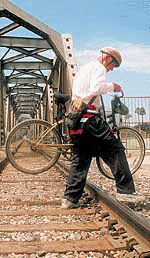 |Home|RailLinks|Link-a-Week|Newsletter|RailNews
|Home|RailLinks|Link-a-Week|Newsletter|RailNews
| Go Back | Go Forward |
Suicides and trespassers contribute to
rail deaths
By Andy Castagnola
Ventura County Star writer
Saturday August 26, 2000
Former Amtrak engineer Brian Sims still remembers the man draped
in a raincoat who stepped in front of his train near San Diego.
"Your heart sinks. You swallow your throat. There's a period
of short anger, and you feel absolutely helpless," Sims said
of the 1998 incident.
Sims witnessed two fatalities in one year as a student engineer.
Two years later, he opted for an Amtrak office job.
"You always second-guess yourself," Sims said about his
career choice. "Is this something you really want to do?"
Suicides and accidental pedestrian deaths are familiar scenes on
state and local rails. Eighty-six people were accidentally killed
by trains or train equipment in California last year, twice the
total of the next highest state, Texas.
These are joggers, dog walkers and kids who trespassed onto
private railroad property.
Then there are people who step directly in front of trains on
purpose.
At least three people have committed suicide or apparent suicide
on Ventura County rails this year, and 14 in the past five years,
according to the Star's archives.

This summer, 34-year-old Jude Basil Kumar Abeyratne and Herman
Carlos Castro Sr., 56, took their lives on county rails.
Engineers in both cases said the men walked onto the tracks and
waved their arms, waiting to be hit by 500,000 pounds of moving
steel.
Numbers are higher in San Francisco, where about 50 people have
used Caltrain to take their lives since 1992.
Suicide cases seem to fall between bureaucratic cracks. Railroad
companies are not required to report deaths ruled as suicides, so
the Federal Railroad Administration doesn't keep exact counts.
FRA spokesman Warren Flatau said suicide cases are beyond the
scope of the railroad industry. It's an issue more suited for
behavioral health experts, he said.
"We're not part of the mental health community," Flatau
said. "Our efforts have got to be focused on the majority of
people who think railroad property is public."
FRA and railroad companies such as Amtrak and Union Pacific work
with Operation Lifesaver, a nonprofit organization, to prevent
accidental train deaths.
The keys to keeping people off tracks, Operation Lifesaver
president Eric Jacobsen said, are education, enforcement and
engineering.
About 3,000 Operation Lifesaver volunteers -- mostly train
operators -- visit schools, fairs and offices to preach the
dangers of passing trains.
Jacobsen said people tend to underestimate their speed and power.
A freight train moving at 70 mph needs more than a mile to stop.
Yet people race across tracks to avoid waiting.
Others don't even hear it coming. Flatau said trains are quieter
than they've ever been. New, continuously welded tracks eliminate
the clickity-clack of an approaching train.
Two joggers, for example, never heard the Metrolink train
approach them from behind in a 1997 accident near Corona. At
least one of the joggers was wearing headphones.
"Trespassing incidents are largely preventable," Flatau
said. "They are needless deaths and injuries. We need to
raise the level of awareness, especially among young people."
Flatau also hopes people realize the far-reaching impacts of
train deaths. Passengers and freight are stranded for hours in
the aftermath. And train crews must cope with an overwhelming
feeling of helplessness.
"It isn't just the poor soul run over," Union Pacific
spokesman Mike Furtney said. "There's big-time trauma for
the people running the trains."
Operation Lifesaver also works with local police to encourage
enforcement of trespassing fines.
Fines for walking onto railroad property vary throughout
California, although some state lawmakers are pushing for a $270
across-the-board fine, Jacobsen said.
In addition, railroad companies are experimenting with
engineering solutions to prevent trespassers. Some measures, such
as fencing, can work only in certain locations. Others, such as
cameras connected to law enforcement offices, are costly to
install.
Beyond Operation Lifesaver's three-pronged attack on railroad
fatalities, Amtrak spokeswoman Liz O'Donoghue said the best
prevention might be the deaths themselves.
"The best thing that can happen within a tragedy like this
is that people learn tracks are no place to walk," she said.
| Print this page. |